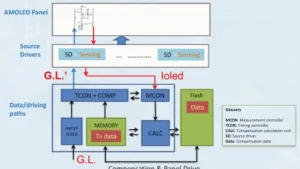It is still true that, for the most part, experienced display evaluators prefer OLED-TVs to quantum-dot-enhanced or RG-phosphor-enhanced LCD-TVs. The evaluators tend to value the color saturation, very dark black levels, good motion rendering, and essentially non-existent halo effect.

But, as my colleague, Bob Raikes, noted in yesterday’s Display Daily (A Couple of Things I’ll Be Looking for at SID), as the luminance of the source material rises beyond a few hundred nits, bright colors lose saturation. With very bright source material (2000 nits or more), the color difference between colors that should be distinct can become very small. Since color differences contribute to rendering of details, an image can appear to lose resolution, in addition to color saturation and contrast.
As Bob mentioned, even Sony — which has become famous for its OLED broadcast monitors — is turning its attention to dual-cell LCD monitors, as are Eizo (using a Panasonic dual-cell panel) and Panasonic itself. In the coming era of UHD source material with 4000 peak nits, OLED monitors will not be able to give content creators an accurate view of what they are creating.
Until now, peak luminance in source material has been limited to 1000 nits, with the average being considerably less. Thus, OLED’s brightness problems have not been serious enough to tip the balance versus its virtues at low and moderate luminace levels.
Another OLED problem, which is related to how hard the panel is driven to produce high brightness, is burn-in. It’s a problem that was widely thought to have been solved for television, if not for commercial signage. But long-term testing by RTINGS.com has convincingly demonstrated that the problem remains, as we have discussed previously in Display Daily.
LG Display and LG Electronics prefer not to discuss burn-in if they can possibly avoid it, but sometimes buried deep within a press release is a comment along the lines of “the set incorporates a sophisticated pixel dimming circuit.” (This is not an exact quote but it’s close to what appeared in the press release announcing LGE’s 88-inch 8K OLED TV.) Now why would you selectively dim pixels, thus compromising the image fidelity you’ve worked so hard to obtain, if it weren’t to moderate something horrible that bright pixels were causing? And what horrible something could that be other than burn-in?
Burn-in comes in two parts. The first is the fatigue of the OLED emissive layers with current and times. The brighter you run the set, the more current passes through the OLEDs, and the quicker the fatigue occurs. The second part is changes in the characteristic of the pixel switch with current and time.
When designers first tried to to drive OLED panels with simple pixel switches made of amorphous silicon, like those used in LCDs, they found that the threshold voltage of the switching characteristic rapidly crept to higher values, thus producing less luminous output for a given input signal. The solution used for TV-sized OLED displays today is to replace the amorphous silicon with a conductive metal oxide (such as IGZO) and to use the IGZO TFTs in a more complicated switching circuit that resisted threshold creep and other changes in the switching characteristic.
Last September at the annual Vehicle Displays Conference held outside Detroit by SID’s Metropolitan Detroit Chapter, Shuenn-Jiun Tang and Junhu He of Ignis Innovations presented the paper “Advanced Compensation Technology for AMOLED Automotive Displays.” Ignis has been working on OLED compensation technologies for nearly 20 years.(Can Ignis Enable the OLED TV Market?) The Vehicle Displays paper describes the company’s current approaches in detail and focuses on automotive applications.
Caption: This block diagram indicates that Ignis Innovations’ compensation algorithm is not simple. (Figure: Ignis Innovations) Click for higher resolution.
Ignis’s pixel circuitry implements in-pixel compensation (IPC), in which the voltage across and current through the AMOLED pixel is monitored and compared with the original voltage and current for the same video input, as well as that of neighboring pixels. Increased current is associated with AMOLED aging, and an algorithm adjusts the current and voltage to compensate. The authors stated that their approach can bring the luminance variation of a burned-in area to under 2%, which is the level at which burn-in is not visible. The result is that up to the lifetime at which uncompensated luminance falls to 50%, compensated luminance can be held to 98% of the initial luminance, and with very high panel uniformity.
Industry sources tell me that the Ignis IPC technology has been licensed to LG Display (Ignis Signs Patent License With LGD), but that company has thus far elected to use internally developed technologies.
Tang and He also recommend an initial external compensation at the factory, in which the pixel luminance is measured directly and non-uniformities corrected with a look-up table. This is done to correct the non-uniformities that are present in newly-minted OLED panels.(shown in our earlier DD article)
At SID Display Week next week, Radiant Vison Systems will show its imaging colorimeter applied to exactly this problem, along with its proprietary technique for pixel-level measurement leading to in-line detection and correction of pixel variations. (Radiant Vision Systems Introduces New ProMetric Y43 Imaging Photometer with 43-Megapixel CCD)
OLED is and will remain a very strong technology for smartphones and, increasingly, automotive applications. We can also expect the market for OLED-TV to expand significantly over the next few years. But for TV, even if an Ignis-like technology can tame the burn-in beast, the limited luminance (or color volume) and the resulting color infidelities with bright program material are problems without obvious solutions. (KW)
Ken Werner is Principal of Nutmeg Consultants, specializing in the display industry, manufacturing, technology, and applications, including mobile devices, automotive, and television. He consults for attorneys, investment analysts, and companies re-positioning themselves within the display industry or using displays in their products. He is the 2017 recipient of the Society for Information Display’s Lewis and Beatrice Winner Award. You can reach him at [email protected].

